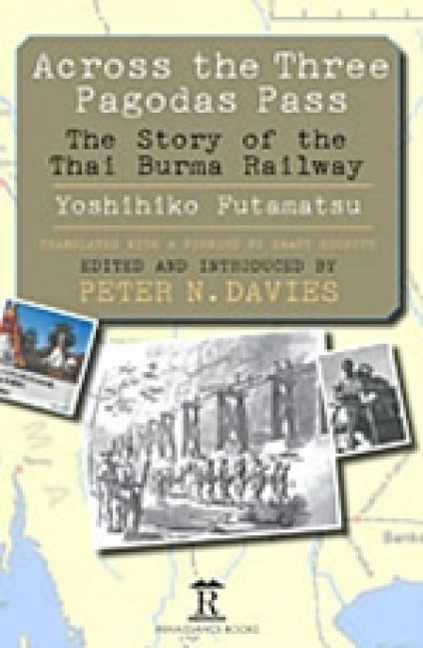Book contents
- Frontmatter
- Dedication
- Contents
- Acknowledgements
- Foreword
- Introduction
- Across the Three Pagodas Pass
- Translator’s Acknowledgements
- Preface
- Chapter 1 Departure for the Front
- Chapter 2 In Indo-China
- Chapter 3 Opening of Hostilities
- Chapter 4 The River Krian
- Chapter 5 The Malayan Campaign
- Chapter 6 The Fall of Singapore
- Chapter 7 Surrender
- Chapter 8 Shōnan: Light of the South
- Chapter 9 The Thai-Burma Railway
- Chapter 10 Preparing Construction
- Chapter 11 Banpong
- Chapter 12 Prisoners-of-War
- Chapter 13 Constructing the Railway
- Chapter 14 Thailand
- Chapter 15 The River Kwae Noi
- Chapter 16 The Mae Khlaung Bridge
- Chapter 17 Kanchanaburi
- Chapter 18 The Jungle
- Chapter 19 From Bangkok to Singapore
- Chapter 20 Rush Construction
- Chapter 21 The Base at Wanyai
- Chapter 22 The Labour Force
- Chapter 23 Survey Unit
- Chapter 24 Test Run
- Chapter 25 Bridge-Building and Shifting Earth
- Chapter 26 The Rainy Season: The Monsoon
- Chapter 27 Kinsaiyok
- Chapter 28 Diseases and Epidemics
- Chapter 29 Cattle Drive
- Chapter 30 Living in the Jungle
- Chapter 31 Soon to the Three Pagodas Pass
- Chapter 32 Towards the Setting Sun
- Chapter 33 Opening to Traffic
- Chapter 34 The Bombing
- Chapter 35 End of the War
- Chapter 36 Internment
- Chapter 37 Repatriation
- Footnote
- Postscript
- End Notes
- Glossary
- Bibliography
- Index
Chapter 13 - Constructing the Railway
Published online by Cambridge University Press: 13 May 2022
- Frontmatter
- Dedication
- Contents
- Acknowledgements
- Foreword
- Introduction
- Across the Three Pagodas Pass
- Translator’s Acknowledgements
- Preface
- Chapter 1 Departure for the Front
- Chapter 2 In Indo-China
- Chapter 3 Opening of Hostilities
- Chapter 4 The River Krian
- Chapter 5 The Malayan Campaign
- Chapter 6 The Fall of Singapore
- Chapter 7 Surrender
- Chapter 8 Shōnan: Light of the South
- Chapter 9 The Thai-Burma Railway
- Chapter 10 Preparing Construction
- Chapter 11 Banpong
- Chapter 12 Prisoners-of-War
- Chapter 13 Constructing the Railway
- Chapter 14 Thailand
- Chapter 15 The River Kwae Noi
- Chapter 16 The Mae Khlaung Bridge
- Chapter 17 Kanchanaburi
- Chapter 18 The Jungle
- Chapter 19 From Bangkok to Singapore
- Chapter 20 Rush Construction
- Chapter 21 The Base at Wanyai
- Chapter 22 The Labour Force
- Chapter 23 Survey Unit
- Chapter 24 Test Run
- Chapter 25 Bridge-Building and Shifting Earth
- Chapter 26 The Rainy Season: The Monsoon
- Chapter 27 Kinsaiyok
- Chapter 28 Diseases and Epidemics
- Chapter 29 Cattle Drive
- Chapter 30 Living in the Jungle
- Chapter 31 Soon to the Three Pagodas Pass
- Chapter 32 Towards the Setting Sun
- Chapter 33 Opening to Traffic
- Chapter 34 The Bombing
- Chapter 35 End of the War
- Chapter 36 Internment
- Chapter 37 Repatriation
- Footnote
- Postscript
- End Notes
- Glossary
- Bibliography
- Index
Summary
The railway construction was set up and operated by forced labour. For survey, air photographs were taken in advance and on a topographical map the selected route was pegged along the centre of the track. At the same time a detailed investigation was made of track, and gradients and curvatures were decided. On the basis of the route-chart, bridges and location of railtrack were decided, the construction-plan finalized, and putting this all together the volume of work was estimated. So, with this volume, the workforce needed was calculated.
Construction work accordingly got under way. To start with, ground-levelling for the roadbed, digging out and embanking was put in hand: bridges apart, this building work was carried out. When it was finished, the railtrack was laid on top of the roadbed, and the railway line completed.
On Thai-side, in July 1942 the Mōri Survey Unit pushed ahead from Nong Pladuk and set up the survey of the central line. From the Banpong area as far as Kanchanaburi there was a 50 km section of level track, and then the centre line was marked out, construction of the roadbed began immediately.
9 Railway Regiment, as construction unit on Thai-side, moved station to Banpong from the Burma front in June by way of Singapore and Bangkok. Regimental HQ at Banpong supervised supporting units as well as the Regiment itself. Colonel Imai was a soldier but he had studied civil engineering at Tokyo Imperial University and made an able commander of railway construction. In January of this year, at the time when I was on bridge operations in Malaya on the River Krian, I had come to know him and so by an odd coincidence had the pleasure of meeting him again. 1 Battalion, having arrived earlier, took charge of survey arrangements. At Banpong 2 Battalion (Yoshida Unit) took charge of track laying, 3 Battalion (Inuyama Unit) and 4 Battalion (Yabe Unit) had the task of building the roadbed between Banpong and Kanchanaburi. Regimental Materials Workshop (Narihisa Unit) at Nong Pladuk and 1 Railway Materials Workshop (Hashimoto Unit) were together responsible for procuring and assembling materials and other resources.
- Type
- Chapter
- Information
- Across the Three Pagodas PassThe Story of the Thai-Burma Railway, pp. 61 - 63Publisher: Amsterdam University PressPrint publication year: 2013



